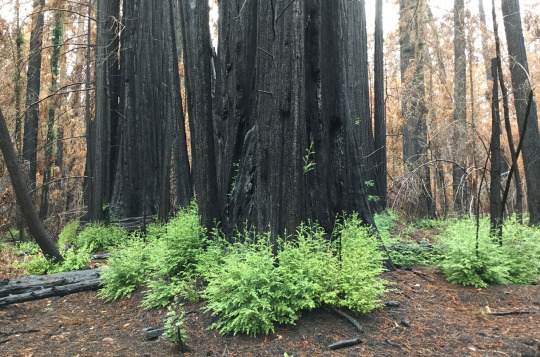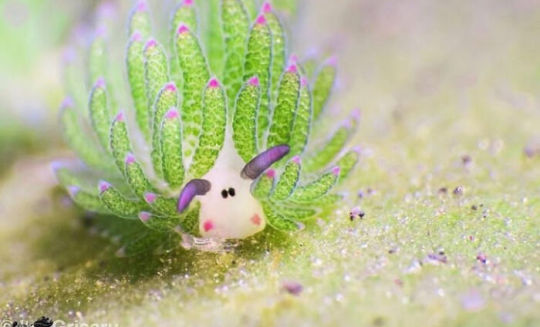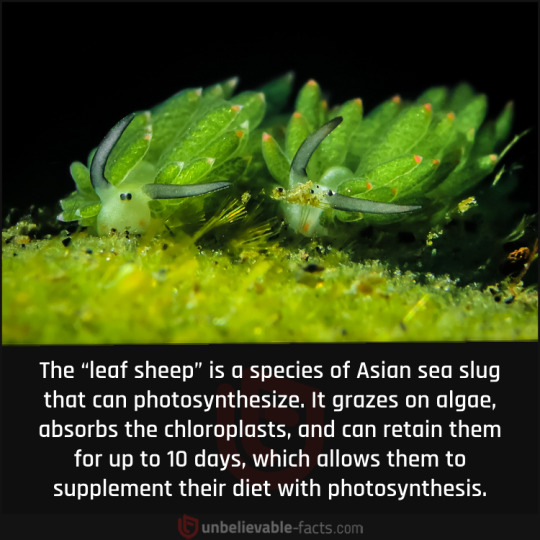#photosynthesis
Text
Classmate: Wait, are you a lesbian?
Me: No, I'm aro ace
Classmate:
Classmate: So you do photosynthesis?
48 notes
·
View notes
Text
Photosynthesis is one of those things that you usually learn about in a simplified way when you're little, that we grow up kinda taking for granted that we "know how that works."
But the process is actually so spine tinglingly bizarre, that if you heard about it for the first time as an adult, you wouldn't even believe it.
Plants are just transmuting light beams into highly complex molecules of sugar. By using the light as a fuckin' battering ram to shatter molecules of water apart. And we're just like "oh yeah, they do that, no big deal" as if that's not a seven layer bizarro dip of what the fuck.
#bad science#science side of tumblr#photosynthesis#science shitpost#I'll never not be impressed by this#yes i know humans can make vit D from the sun#but somehow that's not as compelling to me#although I'm sure it would be if we couldn't 🤷🏻♀️
42 notes
·
View notes
Text
Ancient redwoods recover from fire by sprouting 1000-year-old buds

Article | Paywall free
When lightning ignited fires around California’s Big Basin Redwoods State Park north of Santa Cruz in August 2020, the blaze spread quickly. Redwoods naturally resist burning, but this time flames shot through the canopies of 100-meter-tall trees, incinerating the needles. “It was shocking,” says Drew Peltier, a tree ecophysiologist at Northern Arizona University. “It really seemed like most of the trees were going to die.”
Yet many of them lived. In a paper published yesterday in Nature Plants, Peltier and his colleagues help explain why: The charred survivors, despite being defoliated [aka losing all their needles], mobilized long-held energy reserves—sugars that had been made from sunlight decades earlier—and poured them into buds that had been lying dormant under the bark for centuries.
“This is one of those papers that challenges our previous knowledge on tree growth,” says Adrian Rocha, an ecosystem ecologist at the University of Notre Dame. “It is amazing to learn that carbon taken up decades ago can be used to sustain its growth into the future.” The findings suggest redwoods have the tools to cope with catastrophic fires driven by climate change, Rocha says. Still, it’s unclear whether the trees could withstand the regular infernos that might occur under a warmer climate regime.
Mild fires strike coastal redwood forests about every decade. The giant trees resist burning thanks to the bark, up to about 30 centimeters thick at the base, which contains tannic acids that retard flames. Their branches and needles are normally beyond the reach of flames that consume vegetation on the ground. But the fire in 2020 was so intense that even the uppermost branches of many trees burned and their ability to photosynthesize went up in smoke along with their pine needles.
Trees photosynthesize to create sugars and other carbohydrates, which provide the energy they need to grow and repair tissue. Trees do store some of this energy, which they can call on during a drought or after a fire. Still, scientists weren’t sure these reserves would prove enough for the burned trees of Big Basin.
Visiting the forest a few months after the fire, Peltier and his colleagues found fresh growth emerging from blackened trunks. They knew that shorter lived trees can store sugars for several years. Because redwoods can live for more than 2000 years, the researchers wondered whether the trees were drawing on much older energy reserves to grow the sprouts.
Average age is only part of the story. The mix of carbohydrates also contained some carbon that was much older. The way trees store their sugar is like refueling a car, Peltier says. Most of the gasoline was added recently, but the tank never runs completely dry and so a few molecules from the very first fill-up remain. Based on the age and mass of the trees and their normal rate of photosynthesis, Peltier calculated that the redwoods were calling on carbohydrates photosynthesized nearly 6 decades ago—several hundred kilograms’ worth—to help the sprouts grow. “They allow these trees to be really fire-resilient because they have this big pool of old reserves to draw on,” Peltier says.
It's not just the energy reserves that are old. The sprouts were emerging from buds that began forming centuries ago. Redwoods and other tree species create budlike tissue that remains under the bark. Scientists can trace the paths of these buds, like a worm burrowing outward. In samples taken from a large redwood that had fallen after the fire, Peltier and colleagues found that many of the buds, some of which had sprouted, extended back as much as 1000 years. “That was really surprising for me,” Peltier says. “As far as I know, these are the oldest ones that have been documented.”
... “The fact that the reserves used are so old indicates that they took a long time to build up,” says Susan Trumbore, a radiocarbon expert at the Max Planck Institute for Biogeochemistry. “Redwoods are majestic organisms. One cannot help rooting for those resprouts to keep them alive in decades to come.”
-via Science, December 1, 2023
#redwoods#california#wildfire#climate change#extreme heat#natural disasters#botany#plant biology#photosynthesis#santa cruz#hopepunk#sustainability#climate hope#united states#good news#hope
11K notes
·
View notes
Photo

#Carl Sagan#David Attenborough#James Woods#The Virgin Suicides#Film#Cinema#Documentary#Film Quotes#Movie Quotes#Nature Quotes#Nature#Sun#Plants#Trees#Oak Tree#Woods#Adventures#Photosynthesis#My Forever Mood#<3
9K notes
·
View notes
Text

349 notes
·
View notes
Text


little info dump!
#I think I‘m insane#photosynthesis#chester#norris#original characters#character design#my art#my ocs#ocs#doodle#procreate
285 notes
·
View notes
Text

Leaf slug -Costasiella kuroshimae - Are One Of The Few Animals That Use Algae To Photosynthesize
Bunnystrawbery
#bunnystrawbery#photographer#nature#marine#algae#photosynthesis#leaf slug#leaf sheep#costasiella kuroshimae#reddit
156 notes
·
View notes
Text

812 notes
·
View notes
Text



Peter Fricke
#peter fricke#photograph#plants#hosta#plantcore#plantblr#cottage#fairy#green#greenery#greencore#forestcore#forest#forest aesthetic#art#photo#nature#naturecore#photosynthesis
228 notes
·
View notes
Text

117 notes
·
View notes
Text
The oldest evidence of photosynthetic structures reported to date has been identified inside a collection of 1.75-billion-year-old microfossils, a Nature paper reveals. The discovery helps to shed light on the evolution of oxygenic photosynthesis.
Oxygenic photosynthesis, in which sunlight catalyzes the conversion of water and carbon dioxide into glucose and oxygen, is unique to cyanobacteria and related organelles within eukaryotes. Cyanobacteria had an important role in the evolution of early life and were active during the Great Oxidation Event around 2.4 billion years ago, but the timings of the origins of oxygenic photosynthesis are debated due to limited evidence.
Continue Reading.
140 notes
·
View notes
Photo

Meet the real life “Bulbasaur”! That Pokemon is famous for being a dinosuar-like animal with a flowering green plant that grows on its back and provides energy. It sounds like pure fantasy, but there is actually an animal that has a similar lifestyle...
“There are several species of sea slugs that have evolved to look like leaves. One example is the Elysia chlorotica, also known as the eastern emerald elysia or the "solar-powered sea slug". This species of sea slug is found along the east coast of North America and is known for its bright green color and leaf-like appearance, which allows it to blend in with the surrounding seaweed.
In addition to its leaf-like appearance, the Elysia chlorotica has the unique ability to steal genes from the algae it consumes, allowing it to photosynthesize and use solar energy to survive. This makes it one of the few animals on Earth that is capable of harnessing the power of the sun to meet its energy needs - it can go without eating for 9 months because it can photosynthesize just like a plant while basking in the sun!”
(Source: The Organic Consumers’ Association of Australia Linked In page)
#biodiversity #nature #wildlife #naturephotography #macro #conservation #birds #naturelovers #biodiversit #wildlifephotography #climatechange #environment #sustainability #photography #biology #biodiversidad #animals #insects #ecology #insect #bird #biodiversidade #flowers #macrophotography #naturaleza #forest #perfection #earth #science #wildlifeconservation
#biodiversity#nature#wildlife#nature photography#macro_captures_#conservation#slugs and snails#sea slug#slugs#molluscs#elysia#green#photosynthesis#solar power#weird nature
430 notes
·
View notes
Text

Photosynthesis🌱
#me#summer weather#enjoying the sunshine#sunday scaries#sunday selfie#photosynthesis#sunbathing#curvy girls#girlblogging#green eyes#single#tattooed girls#tumblr girls#red hair#thicc white women#selfie girl#green eyed girl#outdoor girl#thicc women#single woman#selfie gal#single gal#business gal#blue skies#Sunday in the park#feminine#daddy's good girl#sunglasses#lip gloss#glossy lips
45 notes
·
View notes
Photo

“The food cycle in nature.” Everyday Problems in Biology. 1939.
Internet Archive
#diagram#chart#science book#the big picture#sun#energy#soil#photosynthesis#animals#oxygen#nemfrog#1939#1930s#1k
2K notes
·
View notes
Text



more Chess & Norris content….if you even care……
156 notes
·
View notes
Photo

A Liquid Tree? Scientists in Serbia Make Incredible Innovation
Dr. Ivan Spasojevic, Ph.D. in Biophysical sciences, and one of the authors on the project from the Institute for Multidisciplinary Research at the University of Belgrade, developed an innovative tool for reducing greenhouse gas emissions and improving air quality: the liquid tree. Also dubbed LIQUID 3, the novel creation is Serbia’s first urban photo-bioreactor, a solution in the fight for clean air. It contains six hundred litres of water and works by using microalgae to bind carbon dioxide and produce pure oxygen through photosynthesis.
The microalgae replace two 10-year-old trees or 200 square meters of lawn. . The advantage of microalgae is that it is 10 to 50 times more efficient than trees.
Very interesting, especially in urban contexts that can’t support / be reconfigured to support more trees.
I imagine a Solarpunk world where each one of these is sculptural - a work of public art.
304 notes
·
View notes